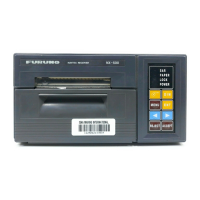
Do you have a question about the Furuno Navtex Receiver NX-500 and is the answer not in the manual?
| Receiving Frequency | 518 kHz, 490 kHz, 4209.5 kHz |
|---|---|
| Dimensions | 240 x 120 x 50 mm |
| Power Supply | 12/24 V DC |
| Interface | NMEA0183 |
| Display | LCD |
| Operating Temperature | -15°C to +55°C |
| Frequency | 518 kHz |
| Language | English, French, Spanish, German, Italian, Portuguese, Russian, Chinese, Japanese, Korean |
Defines the highest level of hazard, indicating potential death or serious injury.
Defines a hazardous situation that could result in death or serious injury if not avoided.
Defines a hazardous situation that could result in minor or moderate injury, or property damage.
Crucial safety advice for operating personnel, covering electrical hazards and equipment handling.
Operational precautions for the operator, including handling liquids and heat near the unit.
Critical safety instructions for installers regarding electrical hazards and proper shutdown procedures.
Installation precautions related to grounding, power supply compatibility, and compass deviation.
Explains the fundamental principles and purpose of the NAVTEX system.
Describes how the world is divided into areas and how stations operate.
Details the structure of NAVTEX messages, including header and terminator codes.
Outlines the rules the receiver follows for acquiring, storing, and printing messages.
Provides a world map illustrating NAVTEX service areas and station locations.
Lists NAVTEX stations by area, country, city, and transmission schedule.
Illustrates the command flow and menu structure for configuring the NX-500.
Describes the physical layout and controls of the NX-500 front panel.
Explains how to turn the unit on/off and its receiving mode.
Guides users through customizing stations, messages, functions, and printout settings.
Details regular checks for the antenna, cables, and connections to ensure performance.
Explains how to replace the fuse and cautions regarding its use and rating.
Lists common symptoms, their possible causes, and remedies for operational issues.
Describes how to run the built-in diagnostic program for performance checks and error detection.
Provides guidelines on selecting a proper mounting location considering environmental factors.
Details options for mounting the main unit: tabletop, bulkhead, or flush.
Guidance on installing passive and active antennas for optimal reception performance.
Instructions for connecting power, antenna, ground, and external data cables correctly.
How to configure antenna selection and grounding for proper operation.
Technical details of the receiver's frequency, sensitivity, and protection features.
Technical details of the thermal printing system, including paper type and speed.
Covers power supply, environmental conditions, dimensions, and weight of the main unit.
Technical details for the optional NX-5 pre-amplifier unit.